Perhaps it's a celebration for the few.
Written by: Deep Tide TechFlow
The major event of the past few days has been the token presale of the meme launch platform Pump.fun.
After much anticipation, PUMP opened its presale on July 12, selling a total value of 500 million dollars in just 12 minutes. This makes one sigh that it's not that the market lacks money, but rather that the money in the market is more inclined to wait and invest in large projects.
As Bitcoin breaks new highs, the presale of PUMP seems to be at a subtle turning point where the market shifts from bullish to bearish, and sentiment turns from pessimistic to optimistic. More people are starting to FOMO, and on Hyperliquid, there are continuously large whales opening long positions.
In contrast, another group of people is feeling dejected for not being able to acquire PUMP through CEX.
Data from Pump.fun's official website shows that several CEXs that previously announced their collaboration for the presale had a 0% share in the total PUMP channels during the successful presale. Meanwhile, a few others with data, such as Kraken, Kucoin, and Gate, accounted for only about 10% of the total PUMP presale.
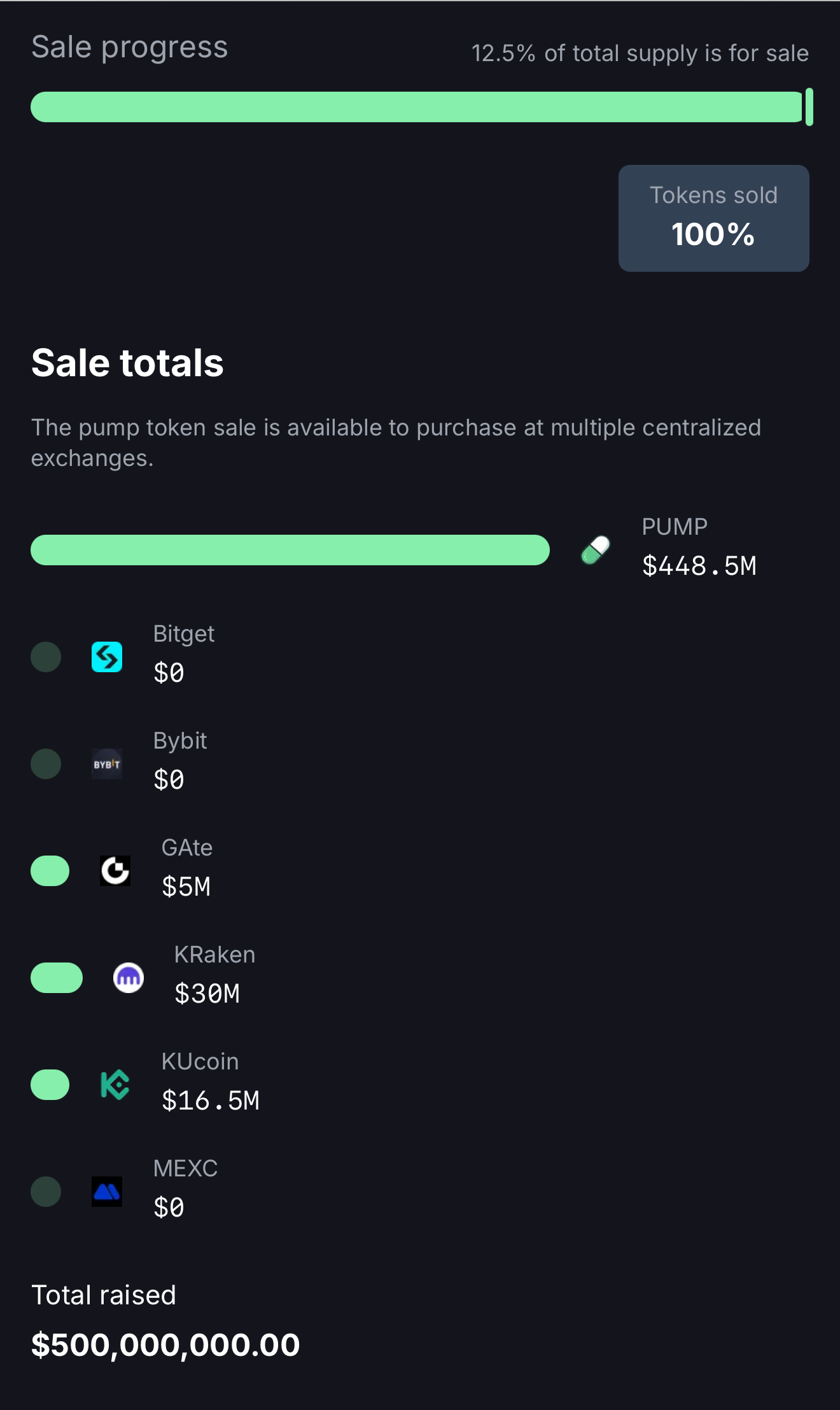
If you also tried to participate in the PUMP presale through CEX, it’s likely that you came up empty-handed.
But don’t be too upset just yet; here are more data points that might help you find some balance — the PUMP presale may indeed be a celebration for the few.
Kraken, a celebration for two
In the prior arrangements, Pump.fun collaborated with six CEXs for the presale; regardless of the specifics of the process and reasons, the results show that three of them had a presale data of 0, which shifts the focus to the other three CEXs that did manage to sell.
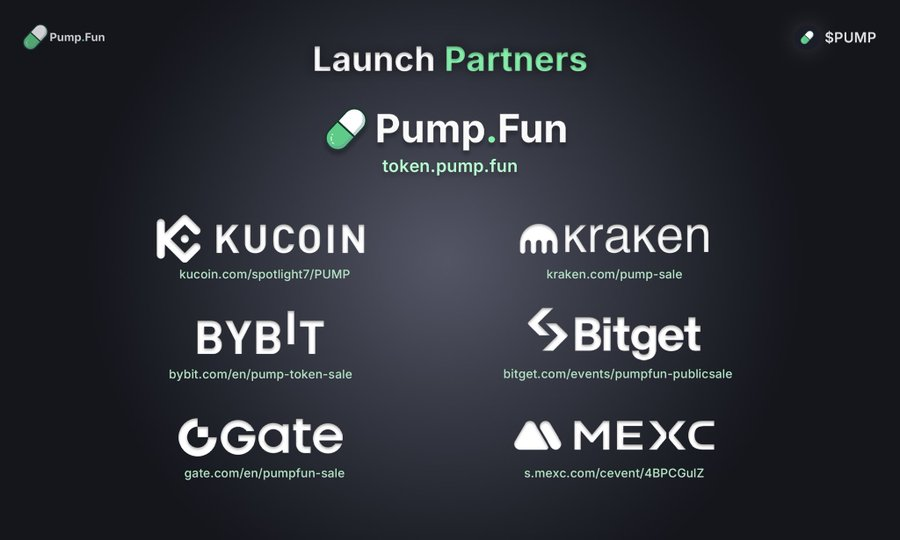
Kraken was the CEX that managed to sell the most shares, generating a total of 30 million dollars in new issuance.
You might think that many users acquired PUMP through Kraken, but the reality is — only 2 people received the allocation.
According to Twitter user @splinter0n, who monitored the presale interface data, the “number of participants” on Kraken during the presale was 2, meaning only 2 individuals participated in the new issuance (2 independent addresses), and they collectively received 30 million dollars in allocation.

(Source: @splinter0n, original post click here)
In the comments section of that post, people discussed who these two individuals might be, but overall, social media tends to believe that this was a layout by powerful whales, and ordinary retail investors simply couldn’t access such large amounts, especially when CEXs collectively faced issues.
Additionally, the blogger presented more data showing that only 15 people participated through Gate, collectively acquiring 5 million dollars; while 120 participants on Kucoin acquired nearly 16.5 million dollars.
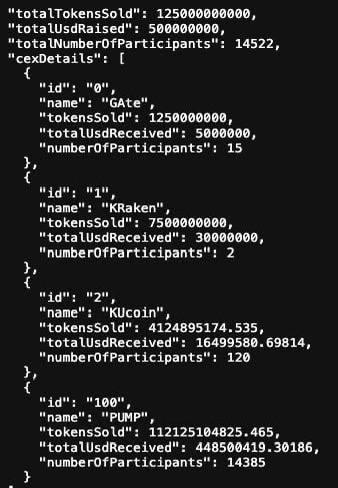
This means that the three exchanges that managed to sell PUMP shares had a total of fewer than 140 participants; considering that one person may hold multiple addresses, this number is likely even lower.
It’s worth noting that regarding the authenticity and credibility of the data, the total number of participants and total amount involved in the presale monitored by the blogger closely aligns with the data presented by Pump.fun.
So, while the official numbers do not specify the number of people who participated in the PUMP new issuance through several CEXs, we have reason to speculate that this is close to the real situation.
In any case, participating in the new issuance through CEX is a celebration for the few, while the majority feel dejected.
Most people only bought 500 dollars
If users who tried to participate in the new issuance through CEX were unable to do so due to process failures, did the retail investors who went directly to the official website make a fortune?
Let’s let the data speak.
The well-known overseas media and data analysis platform Blockworks recently launched a data dashboard that provides a clear view of various data from this PUMP presale.
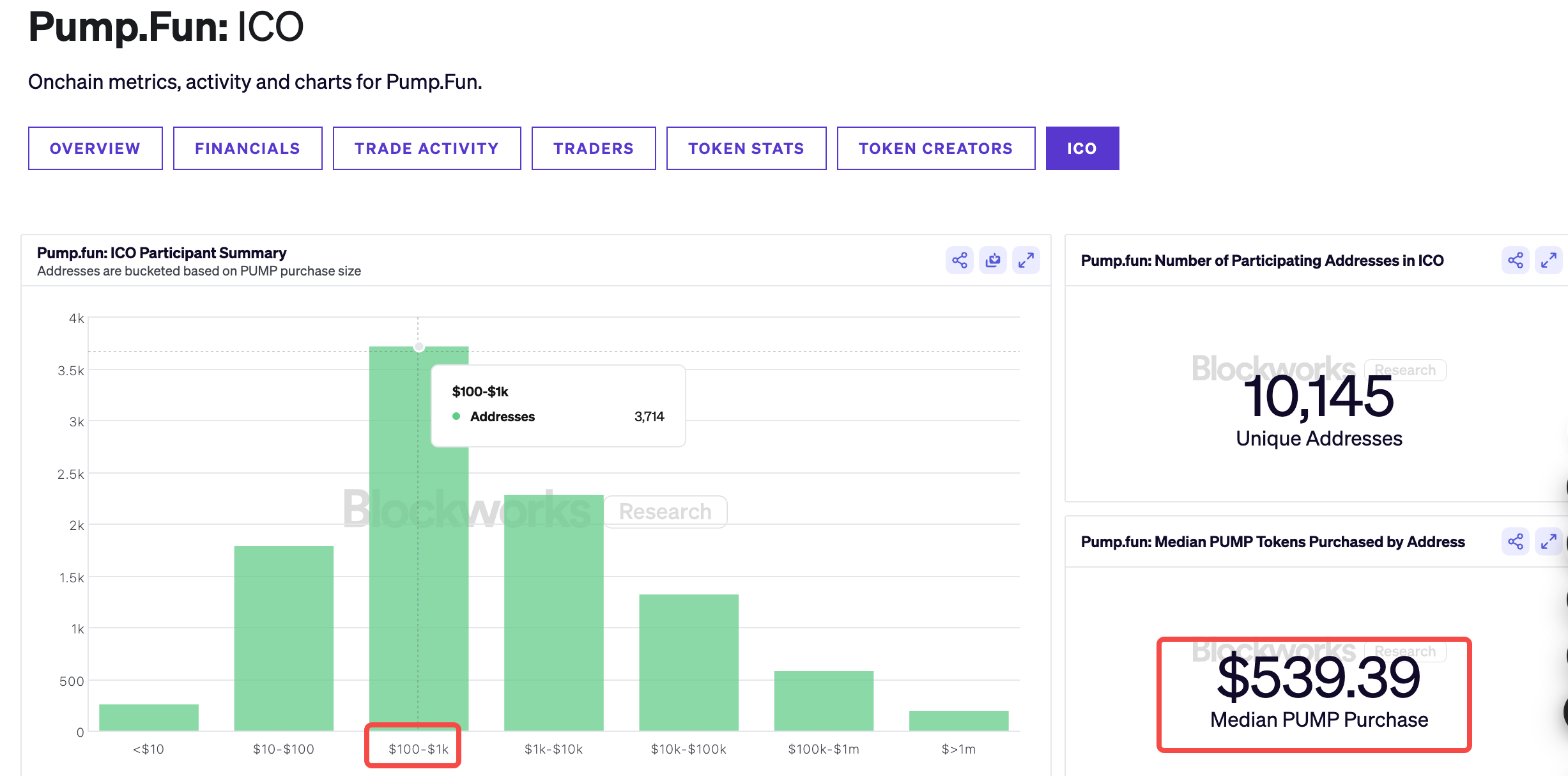
First, a total of 10,000 independent addresses participated in the purchase, with the most concentrated purchase amounts falling in the range of 100 to 1000 dollars, and the median purchase amount being around 540 dollars.
Note that this is the median, not the average, which statistically excludes the situation where the average is inflated by a few super whales' purchases.
This means that most addresses participated with around 500 dollars; and on Twitter, you might find a plethora of complaints about unsuccessful purchases or FOMO posts, making their regret seem as if they had invested hundreds of thousands of dollars.
There is often a huge gap between real data and social media sentiment. Emotions can be amplified, but the money in wallets is limited.
When examining the large holders, there were 202 wallets that purchased amounts exceeding 1 million dollars, and 138 wallets that purchased amounts exceeding 500,000 dollars.
Additionally, there are some interesting data points worth noting.
Among all the wallets participating in the presale, nearly 45% of the new wallet addresses were created within 24 hours.
If there is a purchase limit per wallet in the presale, then large holders and institutions can bypass restrictions by creating multiple new wallets to maximize their purchase amounts.
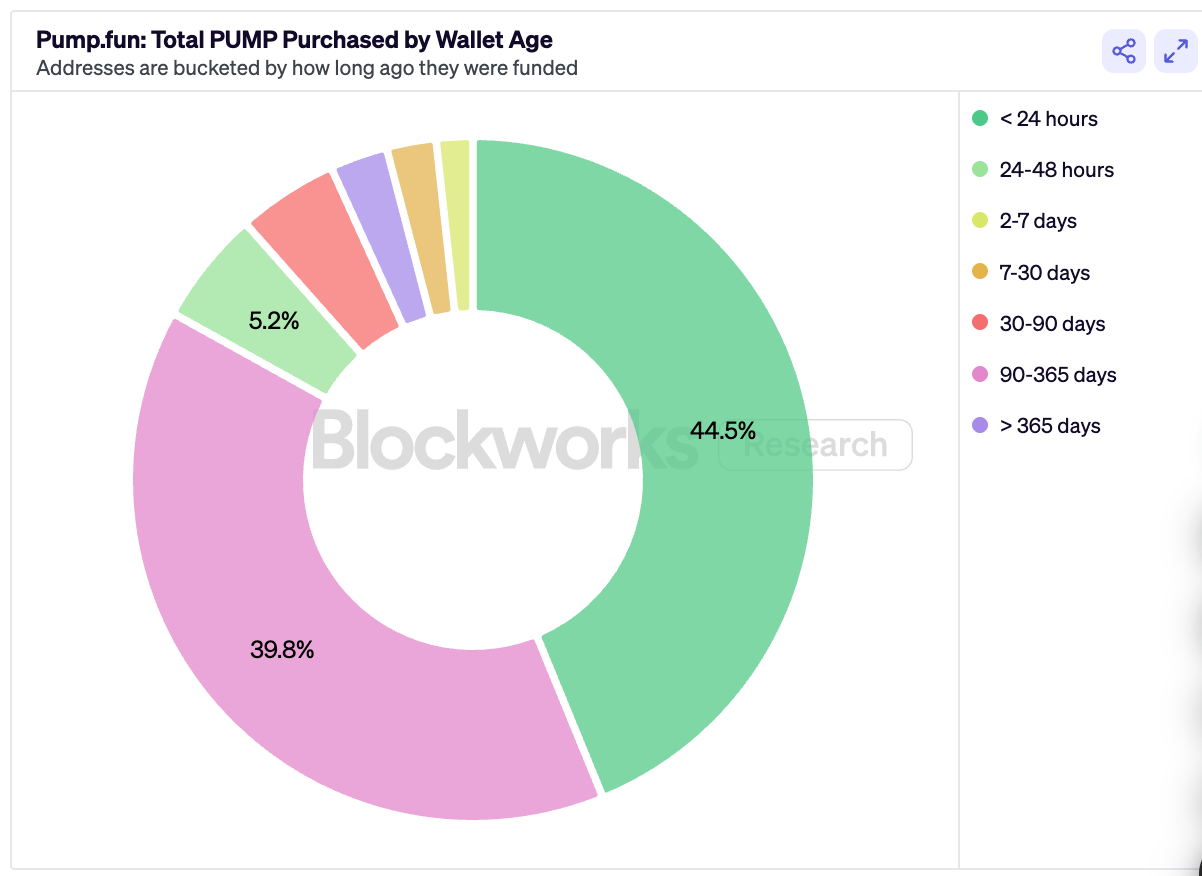
In comparison, wallets that have existed for over a year and participated in the presale account for less than 5%. This supports a viewpoint discussed in the community — the presale is more favorable to large holders, while old retail investors may become “exit liquidity.”
Finally, if we examine the sources of funds for those who directly participated in the presale on Pump's official website, we find that aside from self-created independent addresses, most of the off-chain funds actually came from withdrawals from Binance, with amounts even exceeding the total number of withdrawal addresses from all other CEXs combined.
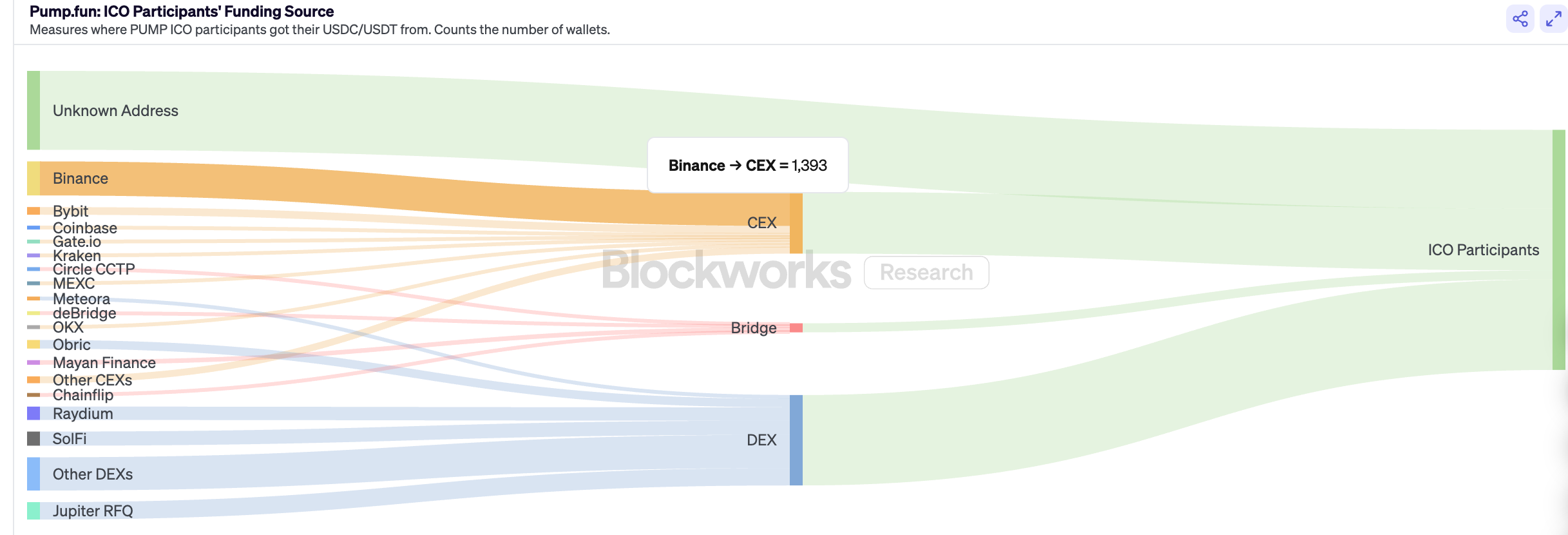
On-chain, DeFi projects in the Solana ecosystem, such as Raydium, SolFi, and Jupiter, contributed a significant amount of funding. When viewed together, the proportion of funds from independent addresses and DEXs among the more than 10,000 participating addresses has exceeded 60%, while CEXs account for less than 30%.
This further emphasizes the importance of channels.
For most crypto projects, the shorter the participation path, the better; people tend to prefer convenience. If one has to withdraw from a CEX to their own address and then participate in the presale, their willingness to participate will inevitably decrease.
Thus, we now see various CEXs embedding on-chain new issuance directly into their app entrances and creating their own on-chain wallets, which is quite reasonable.
Marginalized Walkers
Looking at all the PUMP presale data together, the seemingly open decentralized presale increasingly shows a tendency towards centralization on the data level.
The low-cost creation of new wallets, the long and short positions on Hyperliquid before the launch, and the issues with the participation channels of CEXs… all these factors make the PUMP presale appear more like an elite game and arrangement rather than a community-driven opportunity.
This is not the first time we have seen on social media that the FOMO and criticism surrounding a certain token are amplified. Retail investors always chase the illusion of the “next hundredfold coin,” only to find themselves marginal participants when faced with the data.
As we continue to observe in “dejection,” the market will increasingly rely on the capital flows of a few.
At this moment of Bitcoin's new highs, the marginalized walkers still feel the chill of heights.
免责声明:本文章仅代表作者个人观点,不代表本平台的立场和观点。本文章仅供信息分享,不构成对任何人的任何投资建议。用户与作者之间的任何争议,与本平台无关。如网页中刊载的文章或图片涉及侵权,请提供相关的权利证明和身份证明发送邮件到support@aicoin.com,本平台相关工作人员将会进行核查。




